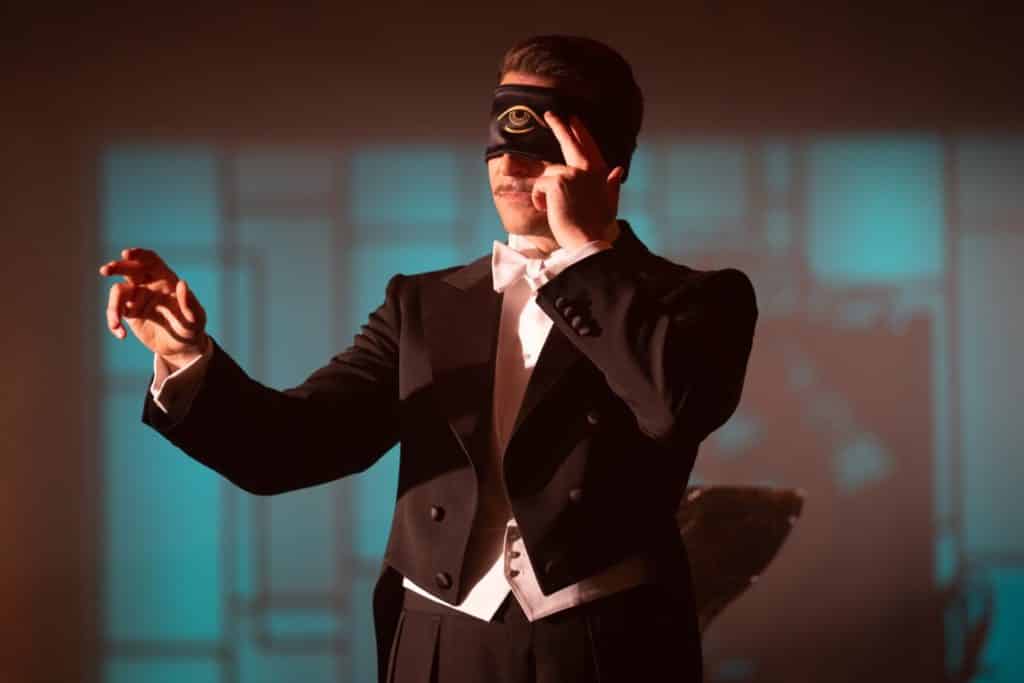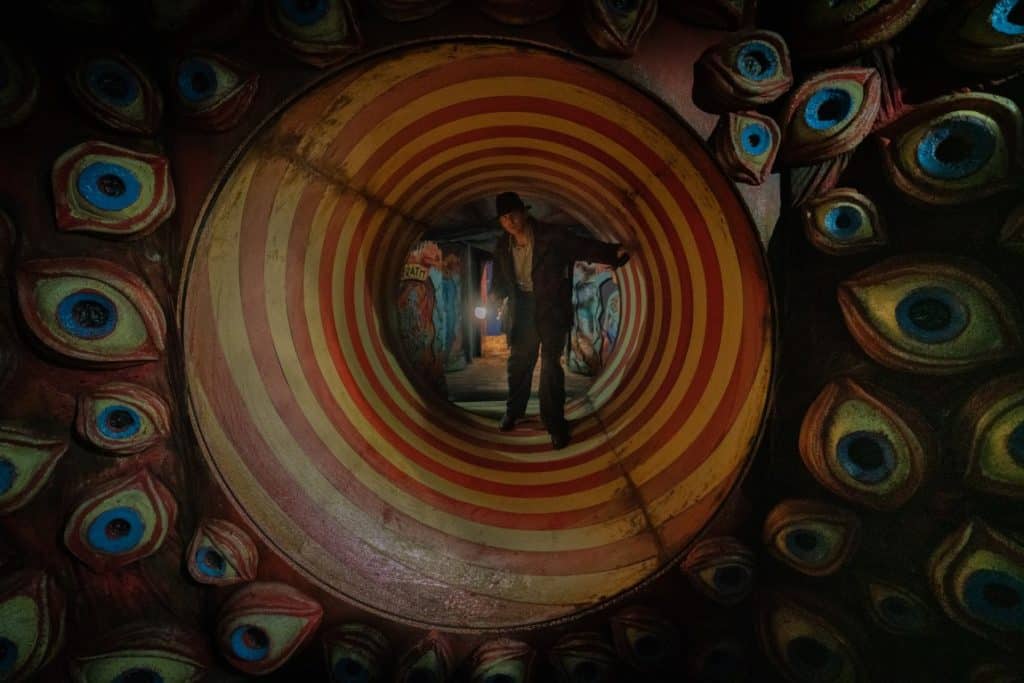The auteur’s update of the 1946 novel is a film noir steeped in too much of his own romanticism.
Back in 1998, Gus Van Sant released his remake of Alfred Hitchcock’s Psycho. It wasn’t a good movie, but it provided two decent critical talking points. Firstly, was it actually a remake, or was it another adaptation of Robert Bloch’s novel? Given that Van Sant’s film was a shot-for-shot recreation of its 1960 predecessor save for two or three differences, it was a rarity in that, given its context, it ended up being the former. It, for all its failures in execution, used semiotics to circumvent the aforementioned semantics of its identity.
Secondly, why did the final product function somewhere between useless and experimental? It’s because it specified the analytical approaches for viewers to take to it. It told them what it was and how to watch it, all void of pretense. Sure, it ultimately elicited these two main considerations to a fault, but it was fascinating in how it did so. It telegraphed that it couldn’t possibly telegraph anything.
Not many movies strike interest because of their mediocrity, and for a while, Guillermo del Toro’s Nightmare Alley feels like another example of that. In theory, it’s another adaptation of William Lindsay Gresham’s 1946 novel. Then, despite having more differences from that film than Van Sant’s Psycho did to Hitchcock’s, it reveals itself to be a pallid remake of a classic.

Of course, the original film in this equation is Edmund Goulding’s 1947 adaptation, which earned dismissal upon release before earning its place in film noir canon. In terms of genre, it was breathless enough to avoid ever getting in its own head. The result was a class critique that even alluded to religion’s apologia for capitalist unjust, and its cynicism, despite its characters being morally tamer than their genre counterparts, stung just as much. Now del Toro tries his hand at the tale, but he can’t let go of his romanticism.
There’s romanticism for the original rather than reverence. The beats are similar; the production design is often the same. It even apes the same mise en scène of Goulding’s film, edging it at points toward patchwork than its own vision. Maybe it’d be easier to defend if del Toro could pick a lane, but by stretching this story another 30 minutes and repeatedly teasing the idea of doing something different, he just keeps pulling his punches. Whatever themes once existed here are just parlor tricks.
At first, Nightmare Alley telegraphs itself as having more bite than it does. Stan Carlisle (Bradley Cooper), in an opening flashier than the original, hides a corpse and sets a house on fire. He’s a con man now onto his next score, soon coming across a traveling carnival belonging to Clem (Willem Dafoe). Opportunity falls into his lap as he makes the acquaintance of psychic Zeena (Toni Colette) and her alcoholic husband, Pete (David Strathairn).
Nightmare Alley is never attuned to what it is or what it’s about.
Stan and Zeena soon scam grieving audience members with a fortunetelling sideshow to contact their dead loved ones. All the while, he woos the young Molly (Rooney Mara), with whom he later leaves the carnival and heads into the city. He welcomes her into his duplicity; the two extend their grifts to the higher-ups of the film’s cookie-cutter urbanity. Then he comes across psychologist Lilith Ritter (Cate Blanchett, easily the brightest spot here), who comes to show hints of a ruthlessness she has to match and combat Stan’s.
But for all its threats of betrayal, Nightmare Alley is never attuned to what it is or what it’s about. On a basic level the film falters: For a story about feigning connection to evade economic downturn, there’s no sense of mendacity. Del Toro’s direction is too romantic to accrue tension, so much so that his Romantic era influences come to add little more than additional brushstrokes to the proscenium covering every scene. The script from him & Kim Morgan, all the while, flirts with treating their work as a derivation while ending up with a shadow of its own ambitions.
It first feels like the movie is being coy. This whole thing is about showmanship, right? To its protagonist, human empathy is really just acting. Being able to activate another person’s memory and have them project a need or wish onto Stan is what pushes the world along. For Nightmare Alley, it’s almost as if it’s trying to excavate a reflection of its source material in order to retell it. It’s almost like it’s meant to be insipid, right? Right?

Tamara Deverell designs it to look like the original, save for an added fascination with analog technology that’s become a del Toro staple. Dan Laustsen’s cinematography, while striking for moments at a time, only really works in its colder moments. Otherwise, it’s either emulating what Lee Garmes composed with Goulding or is stuck under a patina that robs the locales of texture. As for the writing? There’s not much here to speak of beyond its asides that pad out the runtime, altering the pacing and points of view so as to trick the viewer into thinking it’ll zig or zag.
The filmmakers can’t grasp what they’re doing beyond aesthetics, and nor can its cast. Cooper’s performance is too open and one-note, so much so that it’s a wonder Stan’s ulterior motives aren’t evident to those around him. The relationship with Molly feels like an obligation on the film’s part, not the characters’. Some of it is due to Mara, who only snaps back to the present in key scenes. A lot of it, though, is simply due to a lack of chemistry between the two leads—a pairing as detached from its reality as the film itself is.
The showmanship is present. It’s also a sham, not something to complement or contextualize the work at hand. Instead exists a fundamental misunderstanding of its dynamics, artistic or interpersonal. There’s a little more gore. The dialogue is a little more vulgar. Even with that, Nightmare Alley gazes upon its characters but never sees them. As a story, there’s such little idea of what it truly is, losing its sense of both the class struggle at the heart of its thesis and the America that continues to inform it. As a film, it’s a direct remake of something vastly superior, one that lacks the humility to frame its weaknesses as unique.
Nightmare Alley apparates into theaters December 17th.
Nightmare Alley Trailer:
Read next: The Spool's Best New Releases
Streaming guides
The Best Live TV Streaming Services With Free Trial
The praises of live TV streaming services don’t need to be further sung. By now, we all know that compared to clunky, commitment-heavy cable, live TV is cheaper and much easier to manage. But just in case you’re still on the fence about jumping over to the other side, or if you’re just unhappy with ... The Best Live TV Streaming Services With Free Trial
How to Watch Power Book III: Raising Kanan Season 3
Season 3 of the hotly anticipated Power spin-off, Power Book III: Raising Kanan, is arriving on Starz soon, so you know what that means: it’s the ’90s again in The Southside, and we’re back with the Thomas family as they navigate the ins and outs of the criminal underworld they’re helping build. Mekai Curtis is ... How to Watch Power Book III: Raising Kanan Season 3
How to Watch Doctor Who: 60th Anniversary Specials
Ladies and gentlemen, we’re so back! To celebrate Doctor Who’s 60th anniversary, the BBC is producing a three-episode special starring none other than the Tenth/Fourteenth Doctor himself, David Tennant. And to the supreme delight of fans (that would be me, dear reader), the Doctor will be joined by old-time companion Donna Noble (Catherine Tate) and ... How to Watch Doctor Who: 60th Anniversary Specials
Which Netflix Country has Interstellar?
Maybe you’ve just seen Oppenheimer and have the strongest urge to marathon—or more fun yet, rank!—all of Christopher Nolan’s films. Or maybe you’re one of the few who haven’t seen Interstellar yet. If you are, then you should change that immediately; the dystopian epic is one of Nolan’s best, and with that incredible twist in ... Which Netflix Country has Interstellar?
Which Netflix Country Has Each Movie of The Hunger Games?
For whatever reason, The Hunger Games series isn’t available in the same countries around the world. You’ll find the first and second (aka the best) installments in Hong Kong, for instance, but not the third and fourth. It’s a frustrating dilemma, especially if you don’t even have a single entry in your region, which is ... Which Netflix Country Has Each Movie of The Hunger Games?
How to Watch ESPN With A Free Trial
One of the major concerns people have before cutting the cord is potentially losing access to live sports. But the great thing about live TV streaming services is that you never lose that access. Minus the contracts and complications of cable, these streaming services connect you to a host of live channels, including ESPN. So ... How to Watch ESPN With A Free Trial
How to Watch Paramount Network With a Free Trial
To date, Paramount Network has only two original shows on air right now: Yellowstone and Bar Rescue. The network seems to have its hands full with on-demand streaming service Paramount+, which is constantly stacked with a fresh supply of new shows. But Yellowstone and Bar Rescue are so sturdy and expansive that the network doesn’t ... How to Watch Paramount Network With a Free Trial
How to Watch WE TV With a Free Trial
Previously “Women’s Entertainment,” We TV has since rebranded to accurately reflect its name and be a more inclusive lifestyle channel. It’s home to addictive reality gems like Bold and Bougie, Bridezillas, Marriage Boot Camp, and The Untold Stories of Hip Hop. And when it’s not airing original titles, it has on syndicated shows like 9-1-1, ... How to Watch WE TV With a Free Trial
How to Watch Comedy Central With a Free Trial
It’s no coincidence that many of today’s biggest comedians found their footing on Comedy Central: the channel is a bastion of emerging comic talents. It served as a playground for people like Nathan Fielder (Fielder For You), Ilana Glazer and Abbi Jacobson (Broad City), Tim Robinson (Detroiters), and Dave Chappelle (Chappelle’s Show) before they shot ... How to Watch Comedy Central With a Free Trial
How to Watch FX With a Free Trial
You’d be hard-pressed to find a bad show airing on FX. The channel has made a name for itself as a bastion of high-brow TV, along with HBO and AMC. It’s produced shows like Atlanta, Fargo, The Americans, Archer, and more recently, Shogun. But because it’s owned by Disney, it still airs several blockbusters in ... How to Watch FX With a Free Trial
How to Watch TNT Sports With A Free Trial
For many sports fans, TNT is a non-negotiable. It broadcasts NBA, MLB, NHL, college basketball, and All Elite Wrestling matches. And, as a bonus, it also has reruns of shows like Supernatural, Charmed, and NCIS, as well as films like The Avengers, Dune, and Justice League. But while TNT used to be a cable staple, ... How to Watch TNT Sports With A Free Trial